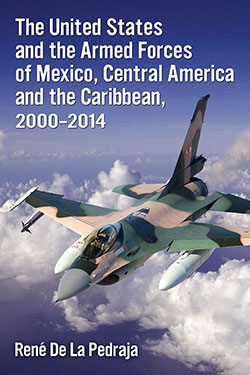The United States and the Armed Forces of Mexico, Central America and the Caribbean, 2000–2014
$39.95
In stock
About the Book
Tracing the U.S. government’s efforts to shape the armed forces of Mexico, Central America and the Caribbean from 2000 to 2014, this narrative concentrates on the Army but also discusses Air Force and naval forces, including the Marines and the Coast Guard. Police forces in those regions are also covered.
Mexico’s ongoing struggle with drug cartels is discussed extensively. Venezuela and Cuba receive considerable attention. This study is the first to examine in detail the armed forces of countries such as the Dominican Republic and Jamaica. Sections on Haiti and Panama, countries supposedly without armies, reveal the decisive role the U.S. has played in determining their military policies.
The text weaves the histories of these armed forces into the broader context of the politics, economics and international relations in the region. A clear and brief introduction to the relations of Mexico, Central America and the Caribbean with the United States is provided.
About the Author(s)
Bibliographic Details
René De La Pedraja
Format: softcover (6 x 9)
Pages: 332
Bibliographic Info: 15 maps, tables, notes, bibliography, index
Copyright Date: 2014
pISBN: 978-0-7864-9508-5
eISBN: 978-1-4766-1776-3
Imprint: McFarland
Table of Contents
Table of Contents
List of Maps ix
List of Tables ix
Preface 1
1. Venezuela: The April 2002 Coup
The Break with the U.S. Government 5
The Attempt to Topple Hugo Chávez 12
The Coup Within the Coup 17
The Counter Coup 19
2. The Expansion of the Armed Forces of Venezuela
The Venezuelan Military Until December 2006 26
The Military and the Presidential Election of 3 December 2006 34
3. Unconditional Allies of the United States
Guatemala: Settling Old Scores with the Army 38
Rebuilding the Army of El Salvador 43
Improving the Armed Forces of Colombia 49
4. Reluctant Mexico
The Role of the Armed Forces in Mexico 55
The Presidency of Ernesto Zedillo, 1994–2000 63
The Presidency of Vicente Fox, 2000–2006, and El Chapo Guzmán 73
5. The Militarization of Colombia and Venezuela
Colombia: Sustaining the Momentum 81
The Venezuelan Military After the Reelection of Hugo Chávez in December 2006 88
6. Shaping the Arsenals of the Armed Forces 93
Nicaragua: Surface to Air Missiles 95
Venezuela: Arms Buildup 99
Mexico: Fighter Jets 105
7. New Complications
Colombia: False Positives 108
Scandals in the Colombian Army 114
Jamaica: Trouble in Paradise 120
8. Central America Turns to the Left
Nicaragua: The Return of the Sandinistas 127
Guatemala: The First Leftist President of the Twenty-First Century 130
El Salvador: The FMLN in Office 135
9. Honduras: The Coup of June 2009
The Presidency of José Manuel Zelaya 144
The Path to the Coup 150
The Coup of 28 June 2009 158
10. Mexico: The Armed Forces Embrace the United States
The Start of the Vicente Calderón Presidency 165
The Military Offensive Against the Drug Cartels, 2008–2010 171
The Battle for Monterrey 184
The Hunt for El Chapo Guzmán 189
11. Mexico: The Presidency of Enrique Peña Nieto 194
Pursuing the Drug Lords 195
The Challenge of Michoacán 198
12. Countries Without Armies
Costa Rica: Creeping Militarization 206
Panama: The Struggle to Demilitarize 211
Haiti: Flawed Demobilization 221
13. An Inconvenient Ally: The Armed Forces of the
Dominican Republic
The Military of the Dominican Republic 227
14. Defiant Cuba 238
Preserving the Revolutionary Legacy 240
The U.S. Vision for Cuba and the Caribbean 251
15. Trying to Dismantle the Bush Legacy 258
Three Explanations 267
Chapter Notes 275
Annotated Selected Bibliography 309
Index 311






